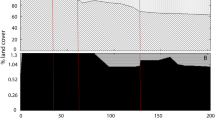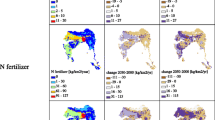Abstract
The concentration of dissolved inorganic nitrogen (DIN), dissolved nitrate-N, Total-N (TN), dissolved inorganic phosphate (DIP), total phosphorus (TP), dissolved silicate-Si (DSi) and their ratios in the world's largest rivers are examined using a global data base that includes 37% of the earth's watershed area and half its population. These data were compared to water quality in 42 subbasins of the relatively well-monitored Mississippi River basin (MRB) and of 82 small watersheds of the United States. The average total nitrogen concentration varies over three orders of magnitude among both world river watersheds and the MRB, and is primarily dependent on variations in dissolved nitrate concentration, rather than particulate or dissolved organic matter or ammonium. There is also a direct relationship between the DIN:DIP ratio and nitrate concentration. When nitrate-N exceeds 100 μg-at l−1, the DIN:DIP ratio is generally above the Redfield ratio (16:1), which implies phosphorus limitation of phytoplankton growth. Compared to nitrate, the among river variation in the DSi concentration is relatively small so that the DSi loading (mass/area/time) is largely controlled by runoff volume. The well-documented influence of human activities on dissolved inorganic nitrogen loading thus exceeds the influences arising from the great variability in soil types, climate and geography among these watersheds. The DSi:nitrate-N ratio is controlled primarily by nitrogen loading and is shown to be inversely correlated with an index of landscape development – the “City Lights” nighttime imagery. Increased nitrogen loading is thus driving the world's largest rivers towards a higher DIN:DIP ratio and a lower DSi:DIN ratio. About 7.3 and 21 % of the world's population lives in watersheds with a DSi:nitrate-N ratio near a 1:1 and 2:1 ratio, respectively. The empirical evidence is that this percentage will increase with further economic development. When the DSi:nitrate-N atomic ratio is near 1:1, aquatic food webs leading from diatoms (which require silicate) to fish may be compromised and the frequency or size of harmful or noxious algal blooms may increase. Used together, the DSi:nitrate-N ratio and nitrate-N concentration are useful and robust comparative indicators of eutrophication in large rivers. Finally, we estimate the riverine loading to the ocean for nitrate-N, TN, DIP, TP and DSi to be 16.2, 21, 2.6, 3.7 to 5.6, and 194 Tg yr−1, respectively.
Similar content being viewed by others
References
Alexander R.A., Smith R.B. and Schwarz G.E. 2000. Effect of stream channel size on the delivery of nitrogen to the Gulf of Mexico. Nature 403: 758–761.
Allen J.R.D., Slinn J., Shammon T.M., Hartnoll R.G. and Hawkins S.J. 1998. Evidence for eutrophication of the Irish Sea over four decades. Limnol. Oceanogr. 43: 1970–1974.
Caraco N.F. and Cole J.J. 1999. Human impact on nitrate export: An analysis using major world rivers. Ambio 28: 167–170.
Clark G.M., Mueleer D.K. and Mast M.A. 2000. Nutrient concentrations and yields in undeveloped basins of the United States. J. Am. Water Res. Assoc. 36: 848–860.
Cloern J.E. 2001. Our evolving conceptual model of the coastal eutrophication problem. Mar. Ecol. Progr. Ser. 210: 223–353.
Conley D.J., Schelske C.L. and Stoermer E.F. 1993. Modification of the biogeochemical cycle of silica with eutrophication. Mar. Ecol. Progr. Ser. 101: 179–192.
Conley D.J. 2000. Biogeochemical nutrient cycles and nutrient management strategies. Hydrobiologia 410: 87–96.
Correll D.L., Jordan T.E. and Weller D.E. 2000. Dissolved silicate dynamics of the Rhode River watershed and estuary. Estuaries 23: 188–196.
del Almo Y., Quéguiner B., Tréguer P., Breton H. and Lampert L. 1997. Impacts of high-nitrate freshwater inputs on macrotidal ecosystems. II. Specific role of the silicic acid pump in the year-round dominance of diatoms in the Bay of Brest (France). Mar. Ecol. Progr. Ser. 161: 225–237.
Dugdale R.C. and Wilkerson F.P. 1998. Silicate regulation of new production in the equatorial Pacific upwelling. Nature 391: 270–273.
Egge J.K. and Aksnes D.L. 1992. Silicate as regulating nutrient in phytoplankton competition. Mar. Ecol. Progr. Ser. 83: 281–289.
Egge J.K. and Jacobsen A. 1997. Influence of silicate on particulate carbon production in phytoplankton. Mar. Ecol. Progr. Ser. 147: 219–230.
Elser J.J., Dobberfuhl D.R., Mackay N.A. and Schampel J.H. 1996. Organism size, life history, and N:P stoichiometry. BioScience 46: 674–684.
Elser J.J., Sterner R.W., Galford A.E., Chrazanowksi T.H., Findlay D.L., Mills K.H. et al. 2000. Pelagic C:N:P stoichiometry in a eutrophied lake: Response to a whole-lake food-web manipulation. Ecosystems 3: 293–307.
Fisher T.R., Harding L.W. Jr, Stanley D.W. and Ward L.G. 1988. Phytoplankton nutrients, and turbidity in the Chesapeake, Delaware, and Hudson estuaries. Estuar. Coastal Shelf Sci. 27: 61–93.
Galloway J.N., Schlesinger H., Levy H. II, Michaels A. and Schnoor J.L. 1995. Nitrogen fixation: Anthropogenic enhancement – environmental response. Global Biogeochemical Cycles 9: 235–252.
Global Environmental Monitoring System 2000. Ontario, Canada, United Nations Environment Programme, Global Environmental Monitoring System, Freshwater Quality Program, Collaborating Centre for Freshwater Quality Monitoring and Assessment at the National Water Research Institute of Environment Canada., http://www.cciw.ca/gems/intro.html.
Goolsby D.A., Battaglin W.A., Lawrence G.B., Artz R.S., Aulenbach B.T., Hooper R.P. et al. 1999. Flux and Sources of Nutrients in the Mississippi-Atchafalaya River Basin: Topic 3 Report for the Integrated Assessment on Hypoxia in the Gulf of Mexico. NOAA Coastal Ocean Program Decision Analysis Series No. 17. NOAA Coastal Ocean Program Office, Silver Spring, MD, 130 p.
Howarth R.E., Billen G., Swaney D., Townsend D.A., Jaworski N., Lajtha K. et al. 1996. Regional nitrogen budgets and riverine N & P fluxes for the drainages to the North Atlantic Ocean: Natural and human influences. Biogeochemistry 35: 75–139.
Humborg C., Conley D.J., Rahm L., Wulff F., Cociasu A. and Ittekkot V. 2000. Silicon retention in river basins: far-reaching effects on biogeochemistry and aquatic food webs in coastal marine environments. Ambio 29: 45–50.
Justic' D., Rabalais N.N., Turner R.E. and Dortch Q. 1995. Changes in nutrient structure of river-dominated coastal waters: stoichiometric nutrient balance and its consequences. Estuar. Coast. Shelf Sci. 40: 339–356.
Le Pape O., del Amo Y., Menesguen A., Aminot A., Quéquiner B. and Tréguer P. 1996. Resistance of a coastal ecosystem to increasing eutrophic conditions: the Bay of Brest (France), a semi-enclosed zone of Western Europe. Cont. Shelf Res. 16: 1885–1907.
Lurry D.L. and Dunn D.D. 1997. Trends in nutrient concentration and load for streams in the Mississippi River Basin, 1974–94. Water-Resources Investigations Report 97–4223. US Geological Survey.
Meybeck M. 1979. Major elements contents of river waters and dissolved inputs to the oceans. Revue de Geologie Dynamique et de Geographie Physique 21: 215–246.
Meybeck M. 1982. Carbon, nitrogen, and phosphorus transport by world rivers. Am. J. Sci. 282: 404–450.
National Research Council [NRC Committee on the Causes and Management of Coastal Eutrophication, Ocean Studies Board and Water Science and Technology Board] 2000. Clean Coastal Waters: Understanding and Reducing the Effects of Nutrient Pollution. National Academy Press, Washington, DC, USA.
Nixon S.W., Oviatt C.A., Frithsen J. and Sullivan B. 1986. Nutrients and the productivity of estuarine and coastal marine ecosystems. J. Limnol. Soc. South Afr. 12: 43–71.
Officer C.B. and Ryther J.H. 1980. The possible importance of silicon in marine eutrophication. Mar. Ecol. Progr. Ser. 3: 383–391.
Peterson B.J., Wollheim W.M., Mulholland P.J., Webster J.R., Meyer J.L., Tank J.L. et al. 2001. Control of nitrogen export from watersheds by headwater streams. Science 292: 86–90.
Rabalais N.N., Turner R.E., Justic' D., Dortch Q., Wiseman W.J. Jr and Sen Gupta B. 1996. Nutrient changes in the Mississippi River and system responses on the adjacent continental shelf. Estuaries 19: 386–407.
Rabalais N.N., Turner R.E., Justic' D., Dortch Q. and Wiseman W.J. Jr 1999. Characterization of Hypoxia: Topic 1 Report for the Integrated Assessment on Hypoxia in the Gulf of Mexico. NOAA Coastal Ocean Program Decision Analysis Series No. 17. NOAA Coastal Ocean Office, Silver Spring, Maryland, USA, 167 pp.
Rahm L., Conley D., Sandén P., Wulff F. and Stånacke D. 1996. Time series analysis of nutrient inputs to the Baltic Sea and changing DSi:DIN ratios. Mar. Ecol. Progr. Ser. 130: 211–228.
Redfield A.C., Ketchum B.H. and Richards F.A. 1963. The influence of organisms on the composition of seawater. In: Hill M.N. (ed.), The Sea. Vol. 2. Interscience Publishers, John Wiley, New York, pp. 26–77.
Revenga C., Murray S., Abramovitz J. and Hammond A. 1998. Watersheds of the World: Ecological Value and Vulnerability. World Resources Institute, Washington, DC, USA, http://www.wri.org/watersheds/index.html.
Schelske C.L., Stormer E.F., Conley D.J., Robbins J.A. and Glover R. 1983. Early eutrophication in the lower Great Lakes: new evidence from biogenic silica in sediments. Science 222: 320–322.
Schindler D.W. 1976. Eutrophication and recovery in experimental lakes: implications for lake management. Science 184: 897–899.
Seitzinger S.P. and Kroeze C. 1998. Global distribution of nitrous oxide production and N inputs in freshwater and coastal marine ecosystems. Global Biogeochemical Cycles 268: 375–379.
Smayda T.J. 1990. Novel and nuisance phytoplankton blooms in the sea: evidence for a global epidemic. In: Granéli E., Anderson D.M., Edler L. and Sundstrøm B.G. (eds), Toxic Marine Phytoplankton. Elsevier Science Publishing Co. Inc., New York, pp. 29–40.
Tilman D., Fargione J., Wolff B., D'Antonio C., Dobson A., Howarth R. et al. 2001. Forecasting agriculturally driven global environmental change. Science 292: 281–284.
Turner R.E. and Rabalais N.N. 1991. Changes in the Mississippi river this century: Implications for coastal food webs. BioScience 41: 140–147.
Turner R.E. and Rabalais N.N. 1994. Coastal eutrophication near the Mississippi river delta. Nature 368: 619–621.
Turner R.E., Qureshi N., Rabalais N.N., Dortch Q., Justic' D., Shaw R. et al. 1998. Fluctuating silicate: nitrate ratios and coastal plankton food webs. Proc. Nat. Acad. Sci. (USA) 95: 13048–13051.
Tréguer P., Nelson D.M., Van Bennekome A.J., DeMaster D.J., Leynaert A. and Queguiner B. 1995. The silica balance in the world ocean – A reestimate. Science 268: 375–379.
van Bennekome A.J. and Solomons W. 1981. Pathways of organic nutrients and organic matter from land to ocean through rivers. In: Martin J.M. and Eisma D. (eds), River Inputs to Ocean Systems. UNESCO&UNEP, SCOR Workshop, Rome, United Nations, New York, pp. 33–51.
Vitousek P.M., Aber J.D., Howarth R.W., Likens G.E., Matson P.A., Schindler D.W. et al. 1997. Human alteration of the global nitrogen cycle: sources and consequences. Ecol. Appl. 7: 737–750.
Vollenweider R.A. 1976. Advances in defining critical loading levels of phosphorus in lake eutrophication. Mem. 1st. Ital. Idrobiol. 33: 53–83.
Vörösmarty C.J., Fekete B.M., Meybeck M. and Lammers R.B. 2000. Global system of rivers: Its role in organizing continental land mass and defining land-to-ocean linkages. Global Biogeochem. Cycles 14: 599–621.
Wafar M.V.M., Le Corre P. and Birrien J.L. 1983. Nutrients and primary production in permanently well-mixed temperate coastal waters. Estuar. Coastal Shelf Sci. 17: 431–446.
Whaby S.D. and Bishara N.F. 1980. The effect of the River Nile on Mediterranean water, before and after the construction of the High Dam at Aswan. In: Martin J.M., Burton J.D. and Eisma D. (eds), River Inputs to Ocean Systems. United Nations, New York, pp. 311–318.
Wollast R. and Mackenzie F.T. 1986. The global cycle of silica. In: Ashton S.R. (ed.), Silicon Geochemistry and Biogeochemistry. Academic Press, London, pp. 39–76.
Author information
Authors and Affiliations
Rights and permissions
About this article
Cite this article
Turner, R., Rabalais, N., Justic', D. et al. Global patterns of dissolved N, P and Si in large rivers. Biogeochemistry 64, 297–317 (2003). https://doi.org/10.1023/A:1024960007569
Issue Date:
DOI: https://doi.org/10.1023/A:1024960007569




